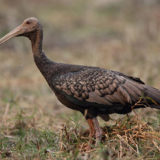Emperor scorpion
Emperor scorpion
Common name: Emperor scorpion, Emperor blue scorpion
Scientific name: Pandinus imperator
Distribution: It is native to Africa.
Description:
The emperor scorpion is one of the largest scorpions in the world. It has a dark black body but the most attracting feature is that it glows bright pastel green or blue under ultraviolet light for which it is popular in pet trade. It is one of the largest species of scorpion in the world with an average length of 7.9 inches, but larger specimens have also been found. The large pincers are blackish red. The frontal part of the body (or prosoma) is made up of four sections, each section containing a pair of legs. Behind the fourth section, are comb like structures known as pectines which is longer in case of males. The tail (or metasoma) is long and curved back over its body. Like all the other scorpions, the tail terminates in a large round receptacle containing the venom gland and tipped with a sharp curved stinger. Sensory hairs cover the pincers and tail, enabling the emperor scorpion to detect prey through vibrations in the air and ground.
Habit and Habitat:
It is found mostly in tropical rain-forests and Savannah. It burrows beneath the ground and hides under rocks. The venom gland contains pandinotoxin and imperotoxin. The venom is mild and mainly used for defensive purposes; they generally use its huge claws to kill prey.
Ecological Importance:
The emperor scorpion eats a variety of insects and arthropods and is preyed upon by by birds, bats, spiders, and other mammals.











